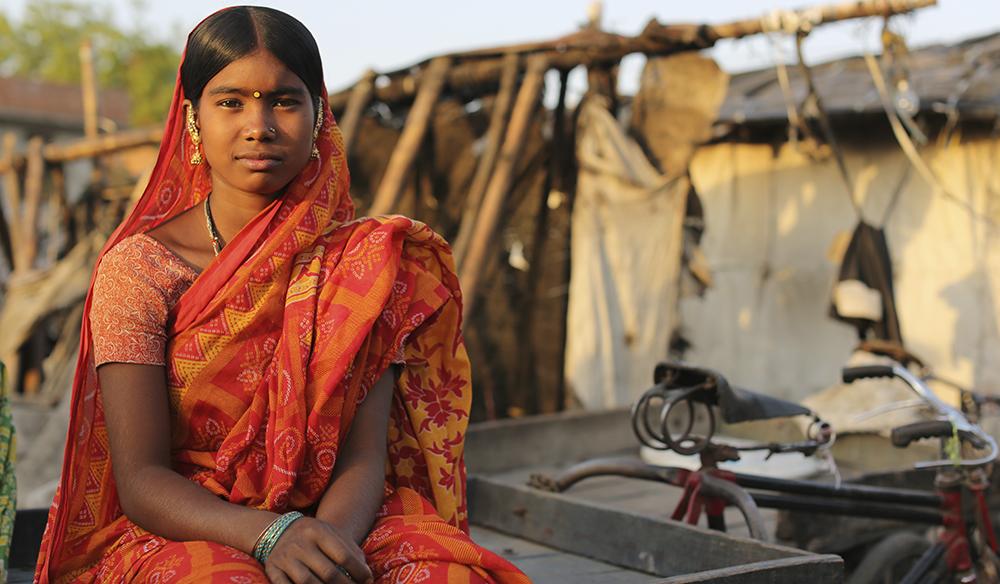Hygiene is health for Indian women
Sanjama showers in the open air and among rubble, hidden from her neighbors by a pair of sheets hung from a wooden pole. Laskshmama defecates in a field a kilometer from her house. When men pass by, she stands up, and when they walk away she bends down again. At 65 years old, she already weighs this work. Nagamma, 38, doesn't complain about doing all the housework, but she finds it unbearable to build roads because she ends up so tired that she even gets a fever. And Mashtanama can no longer work because of the pain she feels in her legs and arms, due to the excess fluoride in the water she drinks. We are in India, in the State of Andhra Pradesh, to which almost 85 million inhabitants belong to the 1,200 million that the country has. In this inhospitable and barren land where drought is a chronic evil, 9.2% of its inhabitants live below the poverty line, half of the population does not have access to latrines and some of the highest percentages are recorded. of the country in water-borne diseases, such as diarrhoea. These four women live in different villages and do not know each other, but they share ailments: they are poor and of low castes, they work in the fields and in the home and do not know what clean water, toilets or personal hygiene are.
Women in India make up 48% of the population but, in a country that looks down on them even before they are born, they bear the brunt. "From the moment a girl is born, she is not considered to belong to the family but to the family of the man she will marry, so she is not invested in," describes Doreen Reddy, director of the women's area of the Fundación Vicente Ferrer (FVF), a Spanish organization that has spent 40 years in this State fighting to eradicate poverty using education and the empowerment of women and the lowest castes as tools.
The Indian woman is responsible for all the household and family duties for her. Her life is hard, especially in the rural environment. “They work about 16 hours a day at home and in the fields, but if they have babies, they have to get up at night to feed them or change their diapers. If a family member is sick, they must care for him. In the end they only manage to sleep four hours at most, because at dawn they have to get up to work. They live for the day, if they don't work one, they don't receive the wages and they can't buy food”, describes Reddy.
Added to this excessive workload is a deterioration in health due to illnesses caused by poor hygiene and by using contaminated water. “Women, in particular, do not take care of themselves, they do not clean themselves, they do not eat well…” says Sirapa, director of the Foundation's Health area. “And, of all those ailments, up to 60% could be avoided if they had access to safe water according to the estimates of the Anantapur district medical coordinator,” she adds. “To clean themselves after defecating, they only use a jug of water that they take with them. They do not wash their hands and then handle the food that everyone later eats at home, and thus they get sick”, completes Shiva Shankar, coordinator of the FVF in Alluru, one of the regions of Andhra Pradesh.
Along with poor hygiene, the other cause of this deterioration in women's health is poor nutrition. "Nutrition is the key, as it prevents anemia and keeps you strong and with high defenses," says Sirapa. But in Andhra Pradesh, 33.5% of women are underweight and 63% of single women between the ages of 15 and 49 suffer from anemia, as do 56.4% of pregnant women, figures much higher than those of men, which are around 20%, according to the latest available report on public health from the Indian Government, from 2013.
Where there are no toilets, there is no health
One of the most touted facts about India around the world is the absence of toilets: almost half of the population, some 597 million people, defecate in the open, a figure that is equivalent to half of all people in the world. in this situation. “We have been promoting the use of toilets for 30 years but until recently we were not successful, their importance in preventing diseases was not understood and people did not want latrines in their homes because they thought they were dirty. Although we built them, they used them as cupboards or even kitchens”, explains Sirapa.
This is the case in the village of Hattie Belgal, where 1,000 people live with one thing in common: they do not have latrines. "Until recently we didn't know about it," confirms Rangama Kathigera, 34, who is a housewife and a government health worker in this town. There the neighbors have organized themselves to relieve themselves in an open space divided by a path that begins where the town ends. On the left are the women and on the right the men.

The most uncomfortable thing is the constant fear of being seen. That is why they resist the desire as long as they can during the day and go at night, but for them it is especially dangerous, since they run the risk of being sexually attacked taking advantage of the fact that there is no light and that they are alone in remote places. “The best time is between four and five in the morning because there is already light so as not to stumble, but there is still not enough light for them to see you,” two elderly women explain. And then, there are the scorpions and snakes, towards which fear does not understand gender: men and women fear being stung, and their reasons are, then, in this State alone, 24,836 people suffered snake bites between January and November 2013. Of these, 104 were fatal.
How far along the parsnip should I cut it if I want two pieces of approximately equal volume? https://t.co/ZhfrcXU9z5
— Alison Kiddle Sun Mar 21 18:21:29 +0000 2021
To put an end to this scourge, the Indian Prime Minister, Narendra Modi, included an ambitious program in the package of measures announced in August 2014, three months after winning the elections: the Swachh Bharat Abhiyan (Clean India Mission) with which he intends to that in 2019 110 million more people have a toilet. In Andhra Pradesh, the FVF has started the construction of the toilets thanks to an agreement reached with the State Government to help all the families that cannot advance the money for the work, a condition imposed on all the beneficiaries.
In Kuruvalli village, they are already beginning to see the benefits of having a toilet at home. A walk through the town, just as poor and austere as the others, gives an idea that the change has begun: here and there spaces under construction proliferate featuring deep holes -the pits- around small huts near the houses . They are the latrines, which half of the neighbors already enjoy. "Now it's very easy," says Parvati succinctly. Across from her, Sujatha, 21, and Saravsfati, 18, listen with envy, as her families have not yet built their own. Both belong to the first generation of women from their village who are attending pre-university education. When they arrived at their student residence on the first day, in the city of Anantapur, they had no idea what a toilet was. “I was nervous because I didn't know how to use it, but my classmates taught me,” says Sujatha. Back home, they find it unbearable to defecate in the field. "It's uncomfortable, people pass by all the time," completes Saravsfati.
Intimate hygiene, another open front
Uncomfortable problems that with a little cleaning would be non-existent, in India they represent the daily life of women. It's not just about having a latrine or washing your hands. The lack of habit and resources to buy pads or tampons when the period comes is another workhorse. “Only those under 30 use modern pads; the older ones wear the same cloth all the time and they don't wash it well, and they don't change their skirts much either, maybe every 15 or 20 days,” says Bahrhamma, a student at the FVF school for female health workers in Madakasira. In this center, 50 women receive training to be the future nurses of their communities. They are the fourth promotion and have been selected because they live in towns where there are no hospitals, no outpatient clinics, no pharmacies, and no transport at hand to go to the nearest health center. During the courses, which began in 2011 and last for a month, they learn to care for minor illnesses and pregnancies and childbirth in order to reduce maternal mortality (110 victims per thousand pregnant women) and infant mortality (39 victims per thousand live births).
The students apply themselves in learning and together they describe the pathologies that women in their villages suffer most often: pelvic inflammatory disease, yeast and vaginal infections and sexually transmitted diseases. According to government data, Andhra Pradesh is the state with the highest incidence of gonorrhea and syphilis. Of the first, 59,557 cases of the 98,000 in 2013 were diagnosed; of the second, they were 22,272 of the 35,000 from all over the country. "They take a shower, but they don't wash their vagina, that's why they get sick," laments Davamani, FVF's health coordinator in Madakasira.
Water that carries diseases
Access to clean water is another major problem in Andhra Pradesh, where it almost never rains and drought is a constant in the lives of its citizens. Ramesh Babu is a doctor at the Foundation and points out that the most common water-borne diseases are typhus, vomiting, stomach worms and diarrhoea. His impression coincides with the data offered by the Ministry of Health: Andhra Pradesh is the second State of India with the highest incidence of diarrheal diseases; in 2013 there were 1,721,050 cases, more than half in women, and one hundred deaths. “The approximate incidence is that, out of 20 patients, four or five come with some ailment related to this problem. And during the monsoon there are more cases because the water drags all the excrement to areas where there is water for consumption and this is contaminated, "says the doctor.
In Hattie Belgal, the village without latrines, there is also no daily drinking water. The neighbors have a 1,000 liter tank that works thanks to an electric pump located in another town. They only have water every four days for four hours, the time that the 80 families of this community have to collect as many pitchers as they can. "The deposit is insufficient, it was built 20 years ago, when the population was half," Rangamma complains. In the living room of her immaculate home, she stores eight small jars covered by a wide sari to keep out bugs. In the kitchen she keeps more water in two other drums: one for cooking and one for drinking. Outside, two more, about 100 liters, to wash clothes and clean up. When there is no electricity, which is common especially in the monsoon season, the pump does not work either, so they have to go to another village four kilometers away to drink.
In the school of Veekajinipalli, a small town of 1,080 inhabitants, a group of 50 neighbors has met to explain their problems with the water. When asked: how many have ever suffered a disease from drinking dirty water?, all raise their hands. And they go beyond diarrhea: Mashtanama, 55, complains of bone pain and assures that in the hospital they have told him that it is because of the water they drink from a nearby dam. Her neighbors nod because they all have something in common that is more palpable than that invisible pain they drag: her teeth are brown and rotten. "It's due to fluorosis," explains Sirapa, from the FVF. Indeed, the water that reaches many communities in Andhra Pradesh contains excess fluoride and its consumption causes long-term problems such as stiffness and pain in the joints, loss of muscle mass, neurological problems and the usual deterioration of tooth enamel.
Practices as simple as boiling water to avoid drinking it contaminated or washing hands after going to the bathroom -or to the open field- are not carried out despite the very long work of raising awareness by the FVF and other NGOs. “We insist that they boil, but they don't put this advice into practice until they get sick. So they do it well but, when they improve, they leave it”, regrets Sirapa. "We know we have to do it but we don't have time," cluck in unison several residents of Veekajinipalli where, furthermore, there are no toilets either. The question has caused debate and some neighbors acknowledge that they know that drinking dirty water causes illness, but they warn that they have a lot of work. "At home, yes, but when we go to the fields we can't boil it, so it's better to get used to it," says Nagamma. “And then there is another added problem -warns Sirapa- and that is that they do not clean the water tanks. They should do it every 15 days but they only add chlorine from time to time without measuring the proportions”. As if that were not enough, not even a measure like boiling water is a definitive solution. Doing so eliminates the microbiological contamination that causes diarrhoea, but not the excess of inorganic substances such as fluorine or arsenic.
definitive solutions
To solve these problems, successful initiatives have been carried out in recent years. One of them has been carried out in the town of Chippagiri, a town that previously had problems of scarcity and excess of fluoride in the water. Now, its 10,000 inhabitants are free of any disease thanks to a purification plant that the FVF built and that the neighbors maintain. The water goes through two filters and through a reverse osmosis process that keeps the parameters at the correct values; then, it is sold both to individuals and to schools, police stations or public bodies at a rate of five rupees (about seven euro cents) per jar. The money collected is deposited in the bank and with it the infrastructure is maintained and a technician is paid to take care of the maintenance.
Another initiative with which good results are being obtained are the integrated neighborhoods that the FVF is building for those with fewer resources. One of them is Vadrahattie, which is about to be occupied by 77 families who used to live in shacks and now have two-room concrete houses with a porch and, most importantly, an improved latrine. In addition, electricity, a clean water well, roads and a primary school have been installed in the community. The neighbors united in a cooperative and bought the land from the Government. Then, the Foundation was in charge of building the infrastructures and the houses.
Bheemappa, 55, and his wife Jaymma, 35, are two of Vadrahattie's new tenants. While showing his old house, from which they have not finished moving, the head of the family explains that every time it rains everything gets wet because the roof, made of palm branches and looking like it will crumble at any moment , filter the water. "But in the neighborhood we won't have to worry about this anymore," he says. Just as happy are Gowaramma, 35, and Gopal, his wife, 25, who are also in the process of moving. Gopal poses with his one-year-old son Vinu at the door of his brand new latrine, and all are good words towards life that start now: “We have a nice house, a lot of light comes in, it is clean and there is space for our child play. And here the water is closer. At the height of his head, Telugu letters adorn the main facade of his new home. The graffiti indicates that she, the woman, is the owner of the house, a condition imposed by the Foundation so that they have something in case they become widows. Her husband Gowaramma doesn't mind at all. “My wife and I live together, what difference does it make who it belongs to? We are Family".


